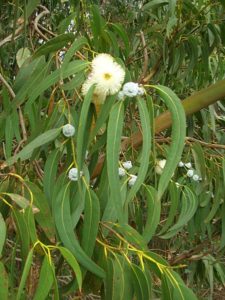Eucalyptus, queen of anti-microbials
Eucalyptus is a strong advocate for our breath, our lungs. In Fall Season, our lungs are featured as the very life-force we consciously depend on, the one energy channel we can control in the moment. Known as a medicinal herb, Eucalyptus is, in my opinion, the queen of anti-microbial essential oils!

With multi-colored bark and fringed creamy flowers, some Eucalyptus trees can grow to a height of over 300 feet! Standing next to such a tree, you could not see its top.
Many of these trees are fire-resistant. However, they are not frost-tolerant—they like warmer climates. A few are naturalized in California.
Eucalyptus on the European market about 1790
Eucalyptus’ popularity as an anti-microbial is attributed to custom and historical precedent. Over 230 years ago the Europeans “discovered” Eucalyptus trees in Recherche Bay, Australia.
But when and how European’s found Eucalyptus trees doesn’t tell the whole story. They were adventuring across waters and in territory unknown to them. Yet these places were quite familiar to the indigenous people, the Aboriginal and Torres Strait Islanders, who had lived and thrived there for thousands of years. Often unremarked in history, original knowledge was aquired by native populations of the South Pacific, who used these trees well before anyone from foreign lands came to take them back to Europe.
Yet Eucalyptus trees were abundant in Australia, and we know there are over 700 species—meaning different kinds—of Eucalyptus trees. The trees populated about three quarters of Australia and so the foreign visitors took advantage of that wealth.
A compellingly attractive scent from Eucalyptus leaves, which some sources describe as having mint-like overtones, would turn out to be a supply of healing balm. It was medicine to rival camphor, at the time a well-known remedy for lung and skin issues—coughs and wounds.
Known for resinous aromas, these Australian and Tasmanian natives are camphor-like, even spicy or citrus-y. Three of the over 700 eucalypts have been well-documented. Their common names are Blue Gum, Narrow-Leaf, and Lemon-scented Eucalyptus. But there are many kinds with perhaps hundreds of variations on scent. These days, Eucalyptus is also grown in India, China, and California and elsewhere.
The viscous substance deemed healthful for the lungs and preventing germs from proliferating in the environment comes from tiny pores on the leaf surfaces that are filled with a highly odiferous resin.
No wonder this tree is queen of anti-microbial essential oils!



